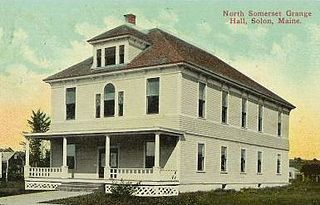
The Grange, officially named The National Grange of the Order of Patrons of Husbandry, is a social organization in the United States that encourages families to band together to promote the economic and political well-being of the community and agriculture. The Grange, founded after the Civil War in 1867, is the oldest American agricultural advocacy group with a national scope. The Grange actively lobbied state legislatures and Congress for political goals, such as the Granger Laws to lower rates charged by railroads, and rural free mail delivery by the Post Office.

Oliver Hudson Kelley is one of the key founders of the National Grange of the Order of Patrons of Husbandry, a fraternal organization in the United States.

This is a list of sites in Minnesota which are included in the National Register of Historic Places. There are more than 1,700 properties and historic districts listed on the NRHP; each of Minnesota's 87 counties has at least 2 listings. Twenty-two sites are also National Historic Landmarks.

Valentown Hall is the name of an abandoned historic shopping and community center located in Victor, New York. The structure was built in 1879 by Levi Valentine, and today it is operated as a museum on the National Register of Historic Places.

Minnehaha Grange, No. 398 was organized on December 23, 1873, with members from Edina Mills, Richfield Mills, St. Louis Park, and Hopkins. The National Grange of the Order of Patrons of Husbandry, commonly known as the Grange, is an organization dedicated to the principles of "progressive agriculture" for the "social fraternity of the farmers". The organization was founded in 1867 by Oliver Hudson Kelley in Elk River, Sherburne County, Minnesota and quickly spread across the country. The fraternity tackled issues such as railroad prices, and providing education to farmers.

The Thorstein Veblen Farmstead is a National Historic Landmark near Nerstrand in rural Rice County, Minnesota, United States. The property is nationally significant as the childhood home of Thorstein B. Veblen (1857-1929), an economist, social scientist, and critic of American culture probably best known for The Theory of the Leisure Class, published in 1899.

The Wendelin Grimm Farmstead is a historic farm near Victoria, Minnesota, United States, listed on the National Register of Historic Places. The farm is located within the boundaries of Carver Park Reserve.

This is a list of the National Register of Historic Places listings in Kandiyohi County, Minnesota. It is intended to be a complete list of the properties and districts on the National Register of Historic Places in Kandiyohi County, Minnesota, United States. The locations of National Register properties and districts for which the latitude and longitude coordinates are included below, may be seen in an online map.
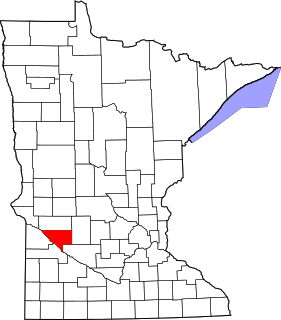
This is a list of the National Register of Historic Places listings in Chippewa County, Minnesota. It is intended to be a complete list of the properties and districts on the National Register of Historic Places in Chippewa County, Minnesota, United States. The locations of National Register properties and districts for which the latitude and longitude coordinates are included below, may be seen in an online map.
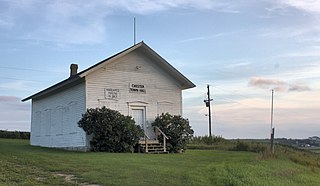
The Bear Valley Grange Hall is a historic meeting hall in Chester Township, Minnesota, United States. It was built in 1874 for the exclusive use of a local chapter of the National Grange of the Order of Patrons of Husbandry, an early farmers' advocacy group and fraternal organization. The chapter folded in the 1880s and the building has been used since as the Chester Town Hall. It was listed on the National Register of Historic Places in 1989 for having local significance in the theme of social history. It was nominated for being the only surviving Grange hall in Wabasha County—and one of only a few in Minnesota—and a rare example of a purpose-built Grange hall, as most chapters met in existing spaces like schools.
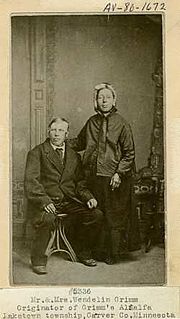
Wendelin Grimm was an American farmer. Grimm is best known for his innovative, seed saving techniques that resulted in North America's first winter-hardy alfalfa.

Crescent Grange Hall #512 is a former meeting hall of the Grange agricultural society in Lindwood Township, Minnesota, United States. It was built from 1881 to 1882 by a chapter of the State Grange of Minnesota, the first state-level subdivision of the National Grange. It was listed on the National Register of Historic Places in 1979 for its local significance in the themes of agriculture and social history. It was nominated for being a well preserved example of an early meeting hall built by a subordinate Grange.

The Bonde Farmhouse is a historic farmhouse located in Wheeling Township in Rice County, Minnesota, United States, approximately 1 mile (1.6 km) from Nerstrand. The private home was placed on the National Register of Historic Places (NRHP) on April 6, 1982. The farmhouse is significant both for its association with a prominent Norwegian immigrant family as well as its local limestone construction and outstanding integrity.

The Charles C. Fitch Farmstead is a historic farm property located in Eugene, Oregon. It was listed as a historic district on the National Register of Historic Places (NRHP) on June 16, 1989.

Oren Cornelius Gregg was a farmer and educator from Minnesota. In the 1880s, agricultural education in Minnesota was in trouble: farmers would not travel to the Twin Cities for classes, and university students did not want to study farming. Gregg, a successful dairy farmer from Lyon County, saved the day by bringing lectures directly to farmers. Beginning in 1885, he led the Minnesota Farmers' Institute, a public lecture series that became the agricultural extension service at the University of Minnesota. Through the institutes that he held across the state, Gregg encouraged farmers to diversify their crops and taught them how to make dairy farming more efficient.

The David Hanaford Farmstead is a historic farm in Monticello Township, Minnesota, United States. It was first settled in 1855 and features a farmhouse built in 1870 and a barn from around the same time. The farmstead was listed on the National Register of Historic Places in 1979 for having local significance in the themes of agriculture and exploration/settlement. It was nominated for being "an excellent example of an early Wright County farmstead developed by a pioneer family from New England."

The Alfred R. Voss Farmstead is a historic farm in Rosendale Township, Minnesota, United States. It was established in the early 1880s by Alfred R. Voss (1860–1952) and grew to become one of the largest private farming operations in late-19th-century southern Minnesota. Its stock barn, built 1893–1896, is one of the largest and most elaborate barns in the state. The farm was listed on the National Register of Historic Places in 1988 for its local significance in the themes of agriculture and architecture. It was nominated for its size, its unusually large and impressive buildings, and its associations with Voss, a land speculator instrumental in the settlement of Watonwan County and later one of the area's most prominent farmers.
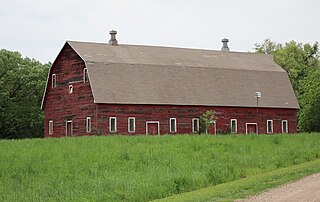
The Christian F. Uytendale Farmstead is a historic farm in Benson Township, Minnesota, United States. The property was established as one of the first farms in Swift County, Minnesota, in 1868, by Norwegian immigrant Johannes Torgerson (1823–1909). In 1879 Torgerson sold it to "Captain" Christian F. Uytendale (1842–1912), a wealthy Danish immigrant who turned the 280-acre (110 ha) farm into a prominent local landmark.






















